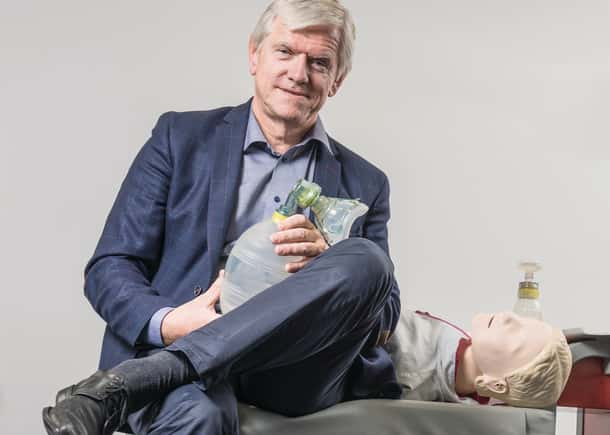Q&A
Changes in healthcare simulation after COVID-19.
Tore Lærdal
CEO, Laerdal Medical

Changes in healthcare simulation after COVID-19.

What has the COVID-19 crisis meant to you?
Our mission of helping save lives has never been more meaningful than now. For more than 60 years, our company mission has been helping save lives. During this time of challenge our commitment to healthcare professionals and our partners in global health has never been more relevant or more important. We’re looking towards the future and how to lead through the inevitable changes in healthcare training and education that will affect our industry and society.
What do we need to do differently in the future?
We know that we need to be better prepared. Hospitals and healthcare systems have had to adapt and enact changes with unprecedented urgency. They’ve had to provide treatment to an influx of patients while, at the same time, ensure the safety of their personnel. We’ve learned that healthcare professionals have to be able to be trained quickly. Expediency is everything.
How has simulation been used to increase preparedness during the pandemic?
Simulation training has been essential to get healthcare workers up to speed quickly. The sudden need for new or novice ICU healthcare workers or those returning to the workforce has resulted in an urgent demand for simulation training to practice the proper use of Personal Protective Equipment, treat COVID-19 patients, and use ventilators. We’ve also seen that the reconfiguration of workspaces and the emergence of pop up hospitals has necessitated in-situ simulation to ensure healthcare providers can work quickly and effectively in these new environments.
What do you think will be different after the pandemic?
I think everything will move into the cloud, with full access to debriefing and simulation sessions data from everywhere in the world available from any portable device. I think there will be more robust simulation training with a focus on decreasing the time it takes to have new staff ready to work. I think we’ll see more investment in healthcare infrastructure, which is needed, but also with conservative financial models. We’ll need to be able to help our customers justify costs by showing that better training leads to better efficiency, performance, and patient outcomes which ultimately leads to cost savings.
What have you learned about innovation during this time?
Due to social distancing, we have seen a vast acceleration of the digital transformation that was already underway. This includes digital simulation solutions, e-learning and self-directed distance learning, as well as webinars and digital simulation industry events. We have also seen the value of peer-to-peer learning methods where students can help teach one another outside the classroom and without exposure to infected patients.
We have had to develop solutions with unprecedented speed like mechanical ventilators that are both easy to use and quick to produce, new apps for teaching ventilation techniques quickly and easily without the need for actual ventilators, and new ways of providing CPR certification and maintenance of competence without access to traditional classroom settings. Innovations that were just starting to reach the mainstream like virtual, augmented, and mixed reality, the use of 3D printing, and harnessing the power of cloud-based big data was at the forefront of the future -- and the future is now.
Are you hopeful for the future?
I am hopeful. This is a time of uncertainty. And uncertainty inevitably causes insecurity. Insecurity about the future – about the health of our families and friends, about the fragility of our healthcare systems, about the safety of our healthcare workers, and about the economic repercussions around the world. This is also a time of great respect, admiration, and appreciation for everyone who is doing their part to help, especially our healthcare providers and partners who are on the frontlines. We have deep gratitude for the sacrifices being made for the sake of the greater good and that gives us great hope. In these times, we can only humbly accept the unknown and do the best we can to take care of each other and to contribute to a better world. At Laerdal, our mantra has always been that we are ‘better together.’ And we will create the future . . . together.